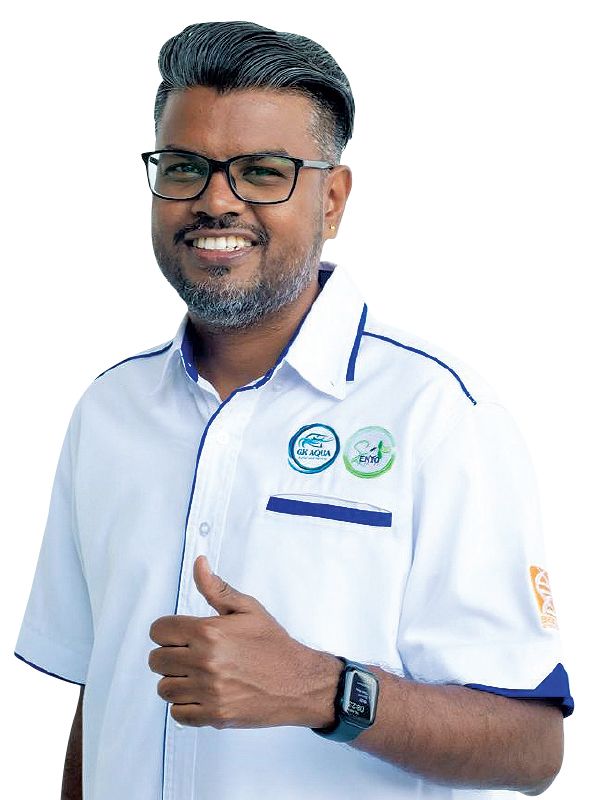
Freshwater prawns produced using GK Aqua’s biotechnology (Photo by GK Aqua)
This article first appeared in Digital Edge, The Edge Malaysia Weekly on April 14, 2025 - April 20, 2025
Growing up in a rubber estate in Teluk Intan, Perak, Giva Kuppusamy developed a fascination for freshwater prawns thriving in nearby rivers. Today, that childhood curiosity has blossomed into a mission to make udang galah, as they’re known locally, more affordable for and accessible to Malaysians through innovative biotechnology.
The CEO of GK Aqua Sdn Bhd has spent years working on the genetics of udang galah, which are often priced out of reach for most consumers due to their low yield and high production costs, compared with more commonly farmed species like Vannamei and Tiger prawns.
“The misperception still exists, people think freshwater prawns are expensive and out of reach,” says Giva, who has worked in a prawn-breeding company and spent six years with the international research organisation Crops for the Future. “Growing up, I saw so many of them in the river. Now, they’ve become a rarity because of overfishing, pollution and environmental degradation.”
One of the key challenges of the industry is biology: female prawns, which make up around 70% of the population, grow significantly slower than males. While females plateau at about 50gm, males can reach 200gm in six months, making the latter far more economically viable for farming.
To address this, Giva and his team developed a breakthrough method using ribonucleic acid interference (RNAi) technology in 2018 to produce an all-male population of prawns. This innovation not only triples the growth rate but also significantly boosts harvest yields.
The process involves injecting RNAi into male prawns, which inhibits male development and turns them into functioning females that are capable of laying eggs. These neo-females are then bred with normal males and because neo-
females don’t carry female chromosomes, all offspring inherit only male chromosomes, producing an all-male line.
GK Aqua’s business model operates on a two-pronged approach: through contracted farmers, it breeds prawns locally for sale, while licensing its proprietary RNAi technology to aquaculture operators overseas. To scale operations and drive adoption, Giva collaborates with banks and fintech partners, making it easier for local farmers to embrace the technology and venture into prawn farming.
The company guarantees to purchase the farmers’ full harvest, removing the burden of marketing and distributing from them. The prawns are then sold under GK Aqua’s consumer brand, M’Ros, to households as well as businesses.
To empower the B40 group to become aquaculture entrepreneurs, GK Aqua launched the Malaysian Udang Galah Aquapreneurs initiative in 2022. “Of course, a lot of people have slammed me with criticism [for wanting to change the community’s way of living]. They asked me, why not just hire foreign labour and pay them RM2,000 to take care of 10 ponds?” Giva shares.
Rather than following conventional wisdom, Giva does not spread his farmers across multiple locations and consolidates operations. “I am [putting all my 80 farmers] in one place [in Rompin, Pahang] and giving them the maximum care [state-of-the-art management practices]. Because at the end of the day, it’s costs, resource sharing and also scalability.”
Another key challenge in the freshwater prawn industry is downstream inefficiencies. Limited market access and price inflation due to multiple intermediaries make udang galah inaccessible to many consumers.
To address this, Giva bypasses the traditional supply chain by bringing his product closer to the end consumer. “We work with restaurants and food outlets so that we literally [integrate] this product in a central kitchen [existing infrastructure]. So, they can have their margin. At the same time, the consumer doesn’t need to pay expensively for it.”
Still, he acknowledges the challenge of price perception. Even with better supply routes, restaurants may continue to position freshwater prawns as a premium item, further inflating prices. GK Aqua, therefore, offers a solution that caters to both ends of the market.
“We sell to the market the affordable [50gm] freshwater prawns. If you want to sell something expensive, sell the premium ones. Don’t take the [lower-grade] ones and overcharge your customers. This is where the unique proposition of udang galah comes in, where it can be premium and affordable depending on size,” says Giva.
A bigger vision
At his flagship 1,000-acre aquaculture project in Rompin, Giva is piloting a new model known as the Carbon Reduction Insular Protein Economy. He intends to make prawn farming more sustainable by moving away from traditional feed sources like sardines and anchovies, the fishing of which is putting pressure on marine ecosystems.
So, Giva is developing an alternative feed using underutilised crops. Tapping his expertise in both aquaculture and sustainable agriculture, he is using hummingbird tree (Sesbania grandiflora) leaves, which contain 30% protein, as feedstock for black soldier fly (BSF) larvae. In turn, these nutrient-rich maggots are then fed to the prawns.
Beyond serving as a sustainable feed, the hummingbird tree offers a host of ecological benefits. Its natural ability to enrich the soil with nitrogen through a symbiotic relationship with nitrogen-fixing bacteria. This helps enhance biodiversity within otherwise monoculture estates.
“This tree fixes its own nitrogen and gives fertility to the soil, improving the soil microbiome. On top of that, it also tackles certain diseases in oil palm plantations,” says Giva. “As you know, Malaysia has five million hectares of oil palm plantations. If we set aside just 20% of that land, that’s a million hectares available [to grown the trees].”
The sustainability cycle continues with the BSF maggot waste, which is repurposed as fertiliser. Tests conducted by the team have shown that it acts as an effective biostimulant for plant growth, adding further value to the integrated model.
This closed-loop system aims to reduce the industry’s carbon footprint while enhancing food security and creating a more resilient aquaculture value chain.
At the Rompin site, Giva’s goal is not only to promote food security but also to ensure income security for farmers. “Now I have an opportunity as a founder of a company. I want to put those perspectives in one place and demonstrate it can be done. Malaysia doesn’t need to import feed ingredients.”
He acknowledges the challenge of perception of industry. “Many might think the industry is dirty, difficult and dangerous. To which I say, don’t make it dirty then.”
He believes technology is essential in transforming the aquaculture sector. Tools such as automation and artificial intelligence can streamline processes, improve precision in farm operations, and reduce manual labour. “We are also coming out with a digital solution app for our farmers, where everything is in the database so they can make better-informed decisions.”
GK Aqua holds a full subscription to ChatGPT, which the team uses to review reports and generate ideas.
Giva himself embraces technology daily. “When I’m driving to the farm in Rompin, which takes three hours, I get a lot of things done just by discussing it with ChatGPT. It sounds nerdy, but that is how it works, and it is what it is,” he says with a laugh.
Having secured close to RM6 million in government grants, GK Aqua is now seeking to raise funds from institutional investors to expand its commercial farm from 50 acres to 500 acres, as part of its planned 1,000-acre aquaculture project. But Giva says the process has highlighted deeper gaps in Malaysia’s investment culture, particularly when it comes to agriculture.
“The reality we live in nowadays … I think the investment portfolio in Malaysia is more towards subscriptions and e-commerce. Tech-wise, very little investments are created, especially when you go to livestock. They always have this fear of ‘what if all the prawns die?’” he says.
Giva stresses the need for a more informed and future-forward approach to agricultural investment. He suggests forming a dedicated committee with expertise in regenerative agriculture to evaluate such ventures, which could unlock more funding opportunities and attract the younger generation to the industry.
“Biotechnology in Malaysia — how many people talk about it? There are a lot of biotech [initiatives], but everything ceases because there are no real activities,” he adds.
Reflecting on his own journey, Giva admits that building GK Aqua has been anything but easy. Fundraising was only one part of the challenge. Early on, assembling a team was just as difficult due to the limited talent pool in the field.
He started GK Aqua in his own backyard, bringing together a team of 10 young scientists. Despite the steep learning curve, Giva invested significant time in training and mentoring them. “Now most of them are seniors with almost five years in the company.”
Today, with a stronger foundation, Giva continues to prioritise talent development. He believes that motivating the next generation is just as crucial as raising capital. Winning the Ernst & Young (EY) Entrepreneur of the Year award for technology in 2023, among other accolades, has helped validate that journey — not just for him, but for his team.
When Giva won an EY award, his mother asked how much money came with it. But for him, the recognition means far more.
“It has been such a challenging journey for us. I never expected to win though, but I’m sure my story, the science and the work spoke for themselves,” he says.
Save by subscribing to us for your print and/or digital copy.
P/S: The Edge is also available on Apple's App Store and Android's Google Play.
- Trump says he is reluctant to keep raising tariffs on China
- US stock rebound fizzles as Trump goes on offensive
- Court orders preacher to pay RM2.5m to KJ for defamatory statements on Covid vaccines
- Chinese tea chain’s US shares rise 43% as IPO defies volatility
- Trump moves to levy Chinese vessels in widening trade war
- Deutsche Bank sees more China clients moving out of US assets
- First phase of diagnosis-related group system, focusing on minor diseases, expected to be implemented by year end, says Dzulkefly
- Increase in online fraud cases, nearly RM600 million losses recorded
- Pahang Sultan calls for definitive end to illegal land encroachment under the guise of agriculture
- Singapore defence minister retires after decades in politics — report

